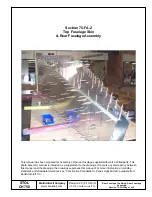
-9-
Pre-flight check
Make it a habit, to do a careful pre-flight check before each start. Functioning
equipment and proper judgment of conditions and the weather reduce the risk
in hang gliding significantly.
1. Check from the nose plate the even bend of both leading edge tubes, the
symmetrical assembly of the glider and the “out” position of safety snap for the
nose wires.
2. Check for easy operation of the VG pulley system and proper functioning of the
VG jam cleat.
3. Base tube installed correctly and no cables kinked and tangs or eyes twisted?
4. Down tubes straight? Keel tube undamaged at control bar apex?
5. Check all lower rig cables, especially at eyes and press fittings.
6. Lift the glider at the rear end of the keel and check with tensioned VG for
symmetry of the glider, the swivel tips right and left and installation of the straight
battens and their secure seat in the double sail seam.
7. Tensioning line/cable ring seated correct in its seat?
8. Is the keel pocket screwed securely to the keel tube?
9. Are both pilot Hang strap and Safety strap correctly fastened and undamaged?
Periodically and after a crash inspect in addition:
All tubes for dents and bends as described in the maintenance and repair
protocol.
Upper and lower rigging right and left and the lines and cables inside the double
sail as well as the swivel tip cables.
Batten curves according to the batten chart.
Take-off
Always make a hang check before the start or always get in your harness after it is
hooked to the glider and the karabiner is locked. One standard routine needs to be
adopted. A hook-in check is essential immediately before any start.
The “Kite” is neutral on the shoulders and easy to guide on launch. The integral spring
system keeps the side wires tensioned, even when the VG is off; so there is no problem
to set proper attitudes and balance for the start. Start with a slow jog and accelerate
continuously till lift-off.
Close your harness after you are a safe distance from the ground and the glider
flies self-stabilizing.
Summary of Contents for Kite
Page 1: ...Operating instructions April 2009 bautek Fluggeräte GmbH Gewerbegebiet 54344 Kenn Deutschland ...
Page 15: ... 14 ...
Page 16: ... 15 ...
Page 17: ... 16 ...































